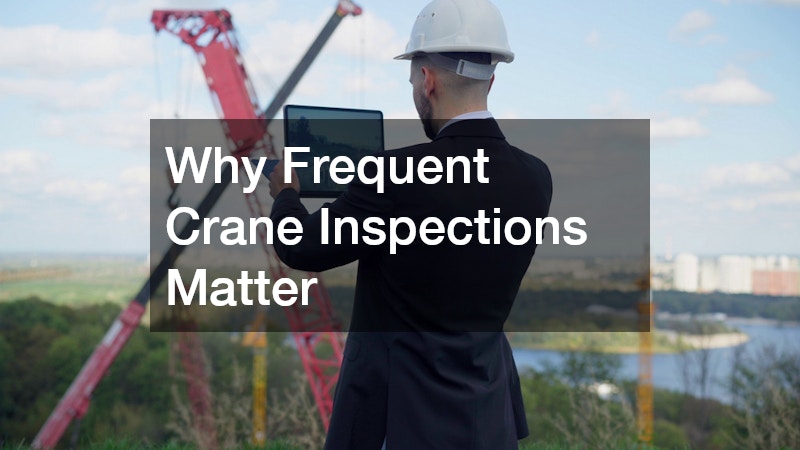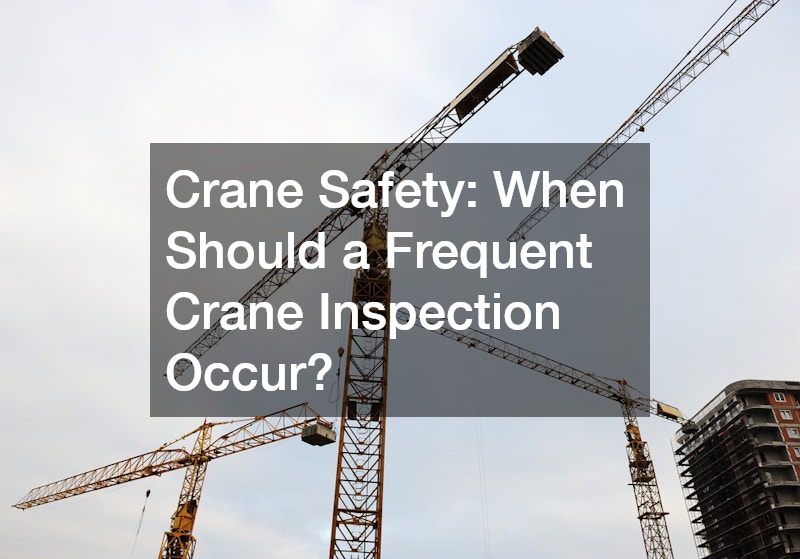Cranes are essential in industries like construction, manufacturing, and shipping. They move heavy loads, speed up projects, and keep production lines running. But cranes also carry serious safety risks if not maintained and inspected regularly. A single overlooked defect can lead to costly breakdowns, injuries, or even fatalities.
One of the most common questions business owners and operators ask is: When should a frequent crane inspection occur? This guide will explain the timing, process, and importance of frequent crane inspections so you can protect your people, your investment, and your business reputation.
Why Frequent Crane Inspections Matter

Frequent inspections are not optional—they’re a legal and safety requirement in most industries. OSHA (Occupational Safety and Health Administration) and other safety authorities require employers to ensure their cranes are inspected often enough to detect problems before they cause accidents.
These inspections:
- Identify early signs of wear and tear
- Prevent costly equipment downtime
- Reduce the risk of workplace accidents
- Ensure compliance with regulatory standards
If your crane fails mid-operation, it’s not just a repair bill you’ll face—it could lead to lawsuits, insurance issues, and project delays.
Understanding the Different Types of Crane Inspections
Before we get into how often “frequent” inspections should happen, it’s important to know there are different types of crane inspections:
- Initial Inspection – Done before a new or repaired crane is put into service.
- Frequent Inspection – Conducted regularly to check for obvious issues that could develop quickly.
- Periodic Inspection – A more thorough examination, often scheduled annually or semi-annually.
While periodic inspections dive deep into the crane’s structural integrity, frequent inspections focus on catching small problems before they become big hazards.
When Should a Frequent Crane Inspection Occur?
OSHA defines “frequent” inspections as those that happen daily to monthly, depending on how often and how intensely the crane is used.
Here’s a breakdown based on usage:
- Heavy Service (used constantly in production or lifting near capacity) – Daily or before each shift
- Moderate Service (used regularly but not always at maximum capacity) – Weekly to monthly
- Light Service (occasional use, low load weights) – Monthly
The inspection should occur before the crane is used for the day or shift to ensure no damage happened overnight or during downtime.
Factors That Influence Inspection Frequency

Not every crane will follow the same schedule. Several factors determine how often inspections should happen:
- Workload – The heavier the loads and the more often the crane is used, the more often inspections should occur.
- Environment – Harsh conditions (dust, salt air, extreme temperatures) require more frequent checks.
- Age of Equipment – Older cranes need closer monitoring to prevent breakdowns.
- Past Performance – If a crane has a history of frequent repairs, inspections may need to be more frequent.
Think of it like owning a vehicle—an older car driven in rough conditions will need maintenance far more often than a new one used lightly.
What a Frequent Crane Inspection Should Include
Frequent inspections aren’t as detailed as periodic inspections, but they still require a thorough check of key safety components.
Items to review include:
- Hooks for cracks, deformation, or wear
- Wire ropes and chains for fraying or corrosion
- Brakes for proper function
- Safety devices and limit switches
- Hydraulic systems for leaks
- Electrical components for damage
- Load controls and warning systems
Small defects found early can be corrected before they cause major failures.
The Role of the Crane Operator in Frequent Inspections
In many workplaces, crane operators perform the initial part of a frequent inspection at the start of their shift. They check for visible issues, unusual noises, or warning indicators.
However, operators are not a replacement for certified inspectors. Operators can report problems, but a trained inspector must evaluate and document findings. This is where knowing who should inspect a crane? becomes important—OSHA recommends that inspections be carried out by a person with the training, experience, and competence to identify hazards.
Documentation and Record-Keeping
It’s not enough to do the inspection—you must also document it. Good records show:
- When the inspection occurred
- Who performed it
- What was checked
- Any issues found and actions taken
Proper documentation not only proves compliance but also helps track recurring problems over time. This information can guide decisions about repairs, upgrades, or replacements.
Common Problems Found During Frequent Inspections
Even though these inspections are brief compared to periodic ones, they often uncover issues that could lead to major failures if ignored. Common findings include:
- Cracks in welds or metal components
- Frayed or damaged wire ropes
- Corroded connections in electrical systems
- Malfunctioning safety switches
- Hydraulic fluid leaks
Addressing these promptly keeps the crane safe and operational.
Who Should Perform a Frequent Crane Inspection?
Frequent inspections are usually done by a designated person—someone with the knowledge and training to spot problems. This can be:
- A certified crane inspector
- A maintenance technician trained on the crane’s model
- The crane operator, if qualified and approved by management
For legal compliance, especially in high-risk environments, a certified inspector is the safest choice.
What Happens If You Skip Frequent Inspections?
Skipping or delaying frequent inspections can have serious consequences:
- Accidents and Injuries – Undetected issues can lead to dropped loads, tip-overs, or structural failures.
- Fines and Legal Trouble – OSHA penalties can be costly, and liability increases if negligence is proven.
- Equipment Damage – Small repairs left unchecked can become expensive overhauls.
- Project Delays – A breakdown mid-project can stop operations entirely.
The cost of an inspection is small compared to the cost of an accident or major repair.
How Frequent Inspections Work With Periodic Inspections
Frequent inspections do not replace periodic inspections—they work together. Frequent checks keep the crane safe day-to-day, while periodic inspections ensure deeper mechanical and structural integrity.
Think of it like visiting the doctor: frequent inspections are like quick checkups, while periodic inspections are full physicals. Both are necessary to maintain long-term health.
Best Practices for Managing Frequent Crane Inspections
For businesses that rely on cranes, a strong inspection process is part of good risk management. Follow these best practices:
- Create a set schedule based on OSHA requirements and manufacturer recommendations.
- Train operators to recognize warning signs.
- Use standardized checklists to ensure nothing is missed.
- Keep clear records of every inspection.
- Act quickly when defects are found.
Final Thoughts
Frequent crane inspections are not just a compliance requirement—they are a smart business practice that protects workers, prevents costly downtime, and maintains your company’s reputation.
The answer to “When should a frequent crane inspection occur?” depends on how often and how hard your crane works, but OSHA’s general guidance ranges from daily to monthly. By following a consistent inspection schedule, documenting results, and working with qualified inspectors, you’ll keep your operations safe and efficient.
In the long run, regular attention to crane safety is far less expensive—and far less risky—than dealing with the aftermath of an avoidable accident.
